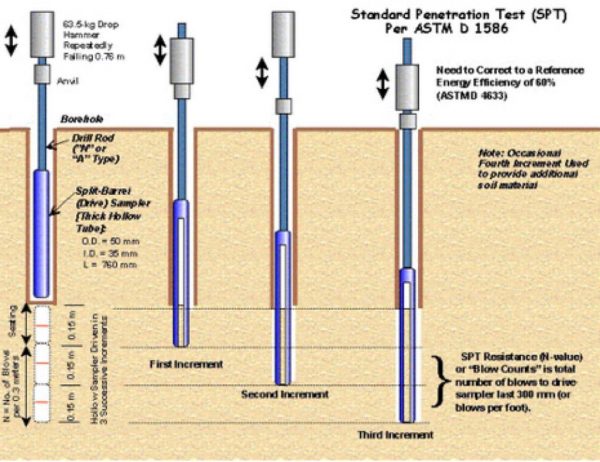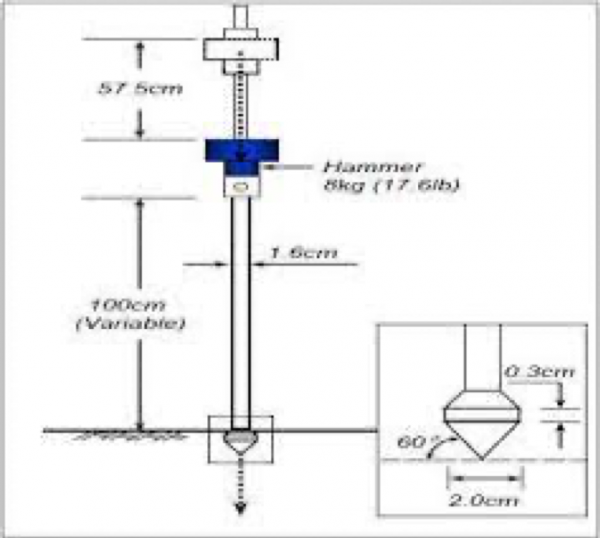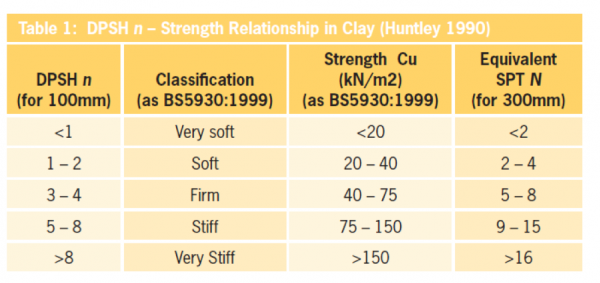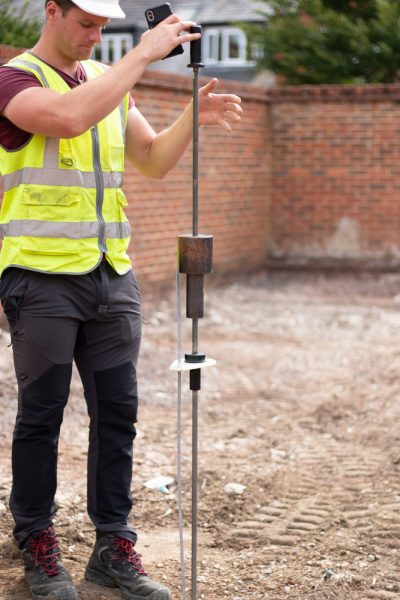The G&W Guide to… SPTs and Dynamic Probes
Geotechnical
 In our series of ‘Ground & Water Guides to…’ we have talked about which types of drilling rig recover the best samples; in turn, these will give you the best results from laboratory tests. We also discussed, in our Site Investigation (SI) Theory Blog, that we are looking for multiple lines of evidence to give us the best likelihood of the correct interpretation. So what other tests can be done, in-situ, which can add to our dataset?
In our series of ‘Ground & Water Guides to…’ we have talked about which types of drilling rig recover the best samples; in turn, these will give you the best results from laboratory tests. We also discussed, in our Site Investigation (SI) Theory Blog, that we are looking for multiple lines of evidence to give us the best likelihood of the correct interpretation. So what other tests can be done, in-situ, which can add to our dataset?
The Standard Penetration Test
The first, and most common type of test, is the Standard Penetration Test or SPT. See the driagram below.
 The tool is used to correlate the resistance of a soil (granular or cohesive) to percussive penetration to determine its undrained shear strength (cohesive) or density (granular).
The tool is used to correlate the resistance of a soil (granular or cohesive) to percussive penetration to determine its undrained shear strength (cohesive) or density (granular).
Generally, there is a sneaky correlation used to give an indication of bearing capacity in cohesive/clay soils. This is SPT X 10 = Bearing Capacity.
However, as with all SI data, the SPT has its pros and cons:
- The SPT can have too much power for soft/firm clays at shallow depth, under-estimating their strength
- It can have too little power at depth in deep boreholes/probes, due to attenuation of torque down the rods. This can result in an over-estimation of strength of materials at depth
- Chalk fracturing can result in an under-estimation of the quality of chalk
- Presence or accumulation of water can result in rogue low values.
User error can also be an issue.
For example, say you have reached 2.0m bgl in sand, and it’s the 10am break time. The drillers have a cup of tea and in the meantime perched water accumulates in the borehole and softens the sand. The SPT wasn’t done before the break and on return the rods are put into the borehole and a test undertaken. This test reveals loose sands and water ingress. The result would have been higher if just done straight away.
Recently, Ground & Water was asked why two reports on the same site had different bearing capacities? One of the theories was as simple as the SPT at 1.0m and 2.0m had been duplicated by error onsite. So record keeping between drillers and engineers is vital, which is why Ground & Water engineers supervise drillers where they can, or, as in our case, have our drillers trained to near engineer standards.
What are the advantages of SPTs?
- It’s a simple low-cost test
- It’s repeatable over 1m intervals
- The test is suitable for many soil types
- It performs in weak rock
- It can be done in most situations
- It can be used to obtains small samples (although they will be disturbed).
Dynamic Probes
Following on from SPTs we have Dynamic Probes, which generally are Super Heavy (SHDP) or just Heavy (HDP) but can be medium (DPM) or light weight (DPL).
Note: Dynamic Probe SHDP or HDP tests are differentiated by drop weight, height and cone weight.
 Basically, the probe is very similar to a SPT, using a drop weight to percussively test penetration in a soil/rock, however, weights and drop height may vary slightly and the readings from a probe are over a 100mm’s of penetration, instead of 300mm.
Basically, the probe is very similar to a SPT, using a drop weight to percussively test penetration in a soil/rock, however, weights and drop height may vary slightly and the readings from a probe are over a 100mm’s of penetration, instead of 300mm.
Pros:
A simple high frequency low-cost test, which is used in conjunction with other methods.
Cons:
- No actual sample is retrieved, so ground conditions need to be interpreted or proved
- Similar to an SPT, it can have too much power for soft/firm clays at shallow depth, under-estimating their strength and it can have too little power at depth in deep boreholes/probes, therefore over-estimating strength of materials at depth.
A ground engineering paper published in March 2007 concluded the following with respect to Dynamic Probes:
- In sands there was no agreement between DPSH blow counts and SPT N value, with the exception of a general trend to have a better correlation at higher densities of material
- DPSH and SPT blow counts in clay were broadly in agreement.

The Ground & Water difference
The key takeaway is that Ground & Water’s Engineers are taught to understand the subtle difference between different in in-situ testing methods. This enables them to spot anomalies or choose the right test for the situation and ground they are dealing with. Their capabilities, and the capabilities of oour highly trained drilling team, help you get the most out of your ground.

 In our series of ‘Ground & Water Guides to…’ we have talked about which types of drilling rig recover the best samples; in turn, these will give you the best results from laboratory tests. We also discussed, in our
In our series of ‘Ground & Water Guides to…’ we have talked about which types of drilling rig recover the best samples; in turn, these will give you the best results from laboratory tests. We also discussed, in our